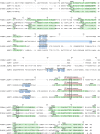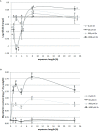SlZRT2 Encodes a ZIP Family Zn Transporter With Dual Localization in the Ectomycorrhizal Fungus Suillus luteus
- PMID: 31681189
- PMCID: PMC6797856
- DOI: 10.3389/fmicb.2019.02251
SlZRT2 Encodes a ZIP Family Zn Transporter With Dual Localization in the Ectomycorrhizal Fungus Suillus luteus
Abstract
Ectomycorrhizal (ECM) fungi are important root symbionts of trees, as they can have significant effects on the nutrient status of plants. In polluted environments, particular ECM fungi can protect their host tree from Zn toxicity by restricting the transfer of Zn while securing supply of essential nutrients. However, mechanisms and regulation of cellular Zn homeostasis in ECM fungi are largely unknown, and it remains unclear how ECM fungi affect the Zn status of their host plants. This study focuses on the characterization of a ZIP (Zrt/IrtT-like protein) transporter, SlZRT2, in the ECM fungus Suillus luteus, a common root symbiont of young pine trees. SlZRT2 is predicted to encode a plasma membrane-located Zn importer. Heterologous expression of SlZRT2 in yeast mutants with impaired Zn uptake resulted in a minor impact on cellular Zn accumulation and growth. The SlZRT2 gene product showed a dual localization and was detected at the plasma membrane and perinuclear region. S. luteus ZIP-family Zn uptake transporters did not show the potential to induce trehalase activity in yeast and to function as Zn sensors. In response to excess environmental Zn, gene expression analysis demonstrated a rapid but minor and transient decrease in SlZRT2 transcript level. In ECM root tips, the gene is upregulated. Whether this regulation is due to limited Zn availability at the fungal-plant interface or to developmental processes is unclear. Altogether, our results suggest a function for SlZRT2 in cellular Zn redistribution from the ER next to a putative role in Zn uptake in S. luteus.
Keywords: Mycorrhiza; Suillus luteus; ZIP; zinc homeostasis; zinc transporter.
Copyright © 2019 Coninx, Smisdom, Kohler, Arnauts, Ameloot, Rineau, Colpaert and Ruytinx.
Figures






Similar articles
-
The SlZRT1 Gene Encodes a Plasma Membrane-Located ZIP (Zrt-, Irt-Like Protein) Transporter in the Ectomycorrhizal Fungus Suillus luteus.Front Microbiol. 2017 Nov 28;8:2320. doi: 10.3389/fmicb.2017.02320. eCollection 2017. Front Microbiol. 2017. PMID: 29234311 Free PMC article.
-
Disentangling the role of ectomycorrhizal fungi in plant nutrient acquisition along a Zn gradient using X-ray imaging.Sci Total Environ. 2021 Dec 20;801:149481. doi: 10.1016/j.scitotenv.2021.149481. Epub 2021 Aug 8. Sci Total Environ. 2021. PMID: 34467922
-
HcZnT2 is a highly mycorrhiza-induced zinc transporter from Hebeloma cylindrosporum in association with pine.Front Plant Sci. 2024 Aug 22;15:1466279. doi: 10.3389/fpls.2024.1466279. eCollection 2024. Front Plant Sci. 2024. PMID: 39239207 Free PMC article.
-
The families of zinc (SLC30 and SLC39) and copper (SLC31) transporters.Curr Top Membr. 2014;73:321-55. doi: 10.1016/B978-0-12-800223-0.00009-8. Curr Top Membr. 2014. PMID: 24745988 Review.
-
Fungal carbohydrate support in the ectomycorrhizal symbiosis: a review.Plant Biol (Stuttg). 2010 Mar;12(2):292-301. doi: 10.1111/j.1438-8677.2009.00312.x. Plant Biol (Stuttg). 2010. PMID: 20398236 Review.
Cited by
-
Gene Copy Number Variation Does Not Reflect Structure or Environmental Selection in Two Recently Diverged California Populations of Suillus brevipes.G3 (Bethesda). 2020 Dec 3;10(12):4591-4597. doi: 10.1534/g3.120.401735. G3 (Bethesda). 2020. PMID: 33051263 Free PMC article.
-
Comparative transcriptomics provides insights into molecular mechanisms of zinc tolerance in the ectomycorrhizal fungus Suillus luteus.G3 (Bethesda). 2024 Sep 4;14(9):jkae156. doi: 10.1093/g3journal/jkae156. G3 (Bethesda). 2024. PMID: 39001865 Free PMC article.
-
Direct transfer of zinc between plants is channelled by common mycorrhizal network of arbuscular mycorrhizal fungi and evidenced by changes in expression of zinc transporter genes in fungus and plant.Environ Microbiol. 2021 Oct;23(10):5883-5900. doi: 10.1111/1462-2920.15542. Epub 2021 May 10. Environ Microbiol. 2021. PMID: 33913577 Free PMC article.
-
Suillus: an emerging model for the study of ectomycorrhizal ecology and evolution.New Phytol. 2024 May;242(4):1448-1475. doi: 10.1111/nph.19700. Epub 2024 Apr 6. New Phytol. 2024. PMID: 38581203 Free PMC article. Review.
References
-
- Alloway B. J. (2004). Zinc in Soils and Crop Nutrition. Paris: International Fertilizer Industry Association and Brussels.
-
- Becquer A., Guerrero-Galán C., Eibensteiner J. L., Houdinet G., Bücking H., Zimmermann S. D., et al. (2019). The ectomycorrhizal contribution to tree nutrition. Adv. Bot. Res. 89 77–126. 10.1016/bs.abr.2018.11.003 - DOI
LinkOut - more resources
Full Text Sources
Other Literature Sources

